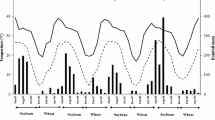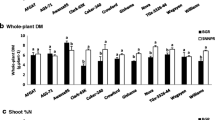Abstract
The practice of seeding soybeans following paddy rice in Thailand has encountered difficulties in seedling germination, nodulation and crop establishment. This research project evaluated the choice of a non-fixing control to quantify N2 fixation by15N isotope dilution, and the effect of tillage regime, soybean cultivar, strain ofBradyrhizobium japonicum and P fertilization on yield and N2 fixation after paddy rice in northern and central Thailand.
Japanese non-nodulating lines Tol-0 and A62-2 were the most appropriatecontrol plants for15N isotope dilution for Thai soybeans in these soils which contained indigenous rhizobia. Cereals such as maize, sorghum and barley were also appropriate controls at some sites. The choice of the appropriate non-fixing control plant for the15N isotope dilution technique remains a dilemma and no alternative exists other than to use several possible controls with each experiment. Acetylene reduction assay (ARA) proved of little value for screening varieties on their N2 fixing capacity.
The recommended Thai soybean cultivars (SJ1, 2, 4, 5) and an advanced line 16–4 differed little in their ability to support N2 fixation or yield, possibly due to similar breeding ancestry. The ten AVRDC (ASET) lines showed considerable genotypic control in their ability to utilize their three available N sources (soil, fertilizer, atmosphere) and to translate them into yields. None of these lines were consistently superior to Thai cultivars SJ4 or SJ5 although ASET lines 129, 209 and 217 showed considerable promise.
Neither recommended Thai or ASET cultivars were affected by tillage regime. Zero tillage resulted in superior N2 fixation and yield at two sites but conventional tillage was superior at another site. Soybean cultivars grown in Thailand were well adapted to zero tillage. Levels of N2 fixation were similar to world figures, averaging more than 100 kg N ha−1 and supplying over 50% of the plant's N yield. However, seed yields seldom exceeded 2 t ha−1, well below yields for temperately-grown soybeans. It is not clear why Thai soybeans support N2 fixation, but do not translate this into higher seed yields.
Similar content being viewed by others
References
Aulakh M S, Rennie D A and Paul E A 1984 The influence of plant residues on denitrification rates in conventional and zero tilled soil. Agron. J. 48, 790–794.
Aulakh M S and Rennie D A 1986 Nitrogen transformations with special reference to gaseous N losses from zero-tilled soils of Saskatchewan, Canada. Soil Tillage Res. 7, 157–171.
Boonkerd N, Rungrattanakasin W, Wadeesirisak P, Kotepongse S and Vasuvat Y 1979Rhizobium japonicum strain selection in Thailand.In Proc. Symp. Somiplan Kuala Lumpur. Ed. Broughton W J. pp 213–223, Univ. Malaysia Press.
Bremner J M 1965 Total nitrogen.In Methods of soil analysis. Ed. C A Black. Agronomy 9, 1149–1178.
Delbert E J, Bijeriego and Olson R A 1979 Utilization of15N fertilizer by nodulating and non-nodulating soybean isolines. Agron. J. 71, 717–723.
Fehr W R, Caviness C E, Burmood D T and Pennington J S 1971 Stage of development descriptions for soybeans,Glycine max. (L.) Merrill. Crop Sci. 11, 929–931.
Fried M and Dean L A 1952 A concept concerning the measurement of available soil nutrient. Soil Science 73, 263–271.
International Rice Research Institute 1978 Annual report for 1977. IRRI. Los Banos, Philippines. 548 pp.
Mariotti A 1983 Atmospheric nitrogen is a reliable standard for natural15N abundance measurements. Nature 303, 685–687.
Patterson T G and LaRue T A 1983 Nitrogen fixation by soybeans: seasonal and cultivar effects, and comparison of estimates. Crop Sci. 23, 488–492.
Porter L K and O'Deen W A 1977 Apparatus for preparing nitrogen from ammonium chloride for nitrogen-15 determinations. Anal. Chem. 45, 514–516.
Rennie R J 1982 Quantifying dinitrogen (N2) fixation in soybeans by15N isotope dilution: The question of the non-fixing control plant. Can. J. Bot. 60, 856–861.
Rennie R J 1985 N2 fixation in temperate legumes.In Nitrogen Fixation Research Progress Eds. H J Evans et al. pp 659–666 Martinus Nijhoff, publishers. Dordrecht, Holland.
Rennie R J 1986 Comparison of methods of enriching a soil with15N to estimate N2 fixation by isotope dilution. Agron. J. 78, 158–163.
Rennie R J and Dubetz S 1984 Multistrainvs single strainRhizobium japonicum inoculants for early maturing (00 and 000) soybean cultivars: N2 fixation quantified by15N isotope dilution. Agron. J. 76, 498–502.
Rennie R J and Rennie D A 1983 Techniques for quantifying N2 fixation in association with non-legumes under field and greenhouse conditions. Can. J. Microbiol. 29, 1022–1035.
Rennie R J, and Rennie D A and Fried M 1978 Concepts of15N usage in dinitrogen fixation studies.In Isotopes in biological dinitrogen fixation. pp 107–133. International Atomic Energy Agency, Vienna.
Ross P J and Martin A E 1970 A rapid procedure for preparing gas samples for N-15 determination. Analyst 95, 817–822.
Steel R G D and Torrie J H 1960 Principles and procedures of statistics. McGraw-Hill, Toronto. 481 pp.
Syarifuddin A K 1982 Tillage practices and methods of seeding upland crops after wetland riceIn Report of a Workshop on Cropping Systems Research in Asia. pp 33–41. IRRI
Wagner G H and Zapata F 1982 Field evaluation of reference crops in the study of nitrogen fixation by legumes using isotope techniques. Agron. J. 74. 607–612.
Witty J F 1983 Estimating N2-fixation in the field using15N-labelled fertilizer: some problems and solutions. Soil Biol. Biochem. 15, 631–639.
Witty J F and Ritz K 1984 Slow-release15N fertilizer formulations to measure N2-fixation by isotope dilution. Soil Biol. Biochem. 16, 657–666.
Author information
Authors and Affiliations
Rights and permissions
About this article
Cite this article
Rennie, R.J., Rennie, D.A., Siripaibool, C. et al. N2 fixation in Thai soybeans: Effect of tillage and inoculation on15N-determined N2 fixation in recommended cultivars and advanced breeding lines. Plant Soil 112, 183–193 (1988). https://doi.org/10.1007/BF02139994
Received:
Revised:
Issue Date:
DOI: https://doi.org/10.1007/BF02139994




